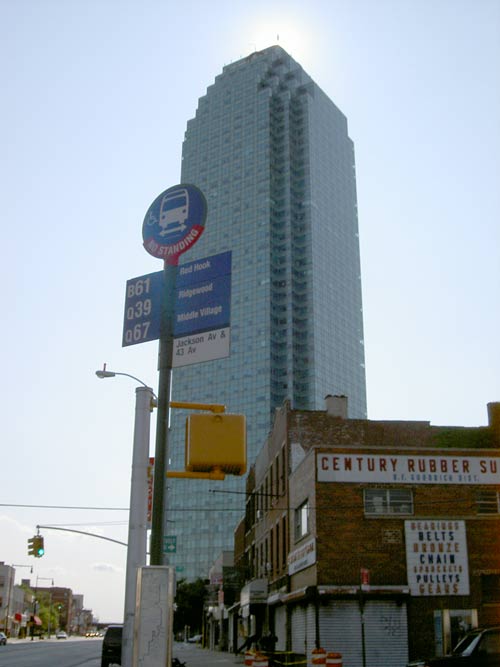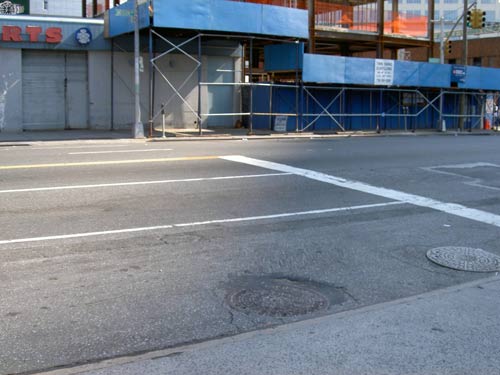September 11th, 2007
Operated by Tycho Brahe in the late 1500s, Uraniborg was the first building ever designed with astronomical observations as its primary design criteria. The towers and balconies were to serve as instrument platforms, and the rooms in the main building were to house Tycho and his family, visiting astronomers, visiting royalty, and students. The alchemical laboratory was in the basement. The orientation of the building was chosen for maximum coverage of the sky with the instruments. Uraniborg was located in the very middle of large walled an intricate garden–In addition to being decorative, the gardens also supplied herbs for the Tycho’s medicinal chemistry experiments. Note sundial in garden, left of castle. More info.
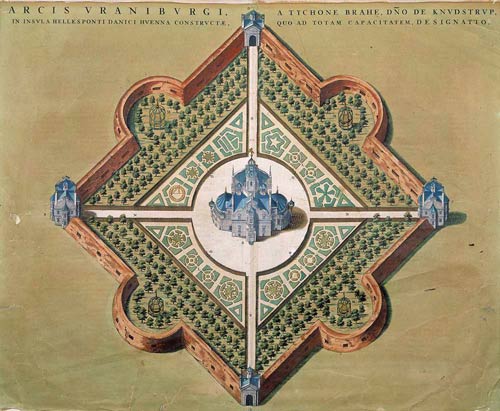
August 28th, 2007
NEIGHBORHOOD REPORT: LONG ISLAND CITY; Controversy Died Down; Wind Hasn’t
By BRUCE LAMBERT
Published: February 6, 1994, The New York Times
Citicorp’s tower, an impressive skyscraper, sometimes sweeps people off their feet — literally. Powerful winds sporadically swirling around it actually lift unwary pedestrians off the ground, neighbors say.
“I know it’s hard to believe, but people get blown into midair,” said Susan P. Chetwin, general manager of the Muzak office across the street on Jackson Avenue. Her workers regularly use the tower for its Citibank branch and basement subway stop.
Jean McIntyre, describing a daily bank errand for Muzak, said, “the wind picked me up completely off the sidewalk — this is no exaggeration — and I was just flying through the air.” She was lifted several inches off the ground and flung about 20 feet away, she estimates.
“It felt like I was going 30 miles an hour. I was headed for a glass window, so I managed to throw myself to the ground to prevent that. I hurt my shoulder, hip and head. I was dazed for a while. I could have been killed there.”
Just what is causing the turbulence is unclear. A Citicorp spokesman said, however, that the company took precautions recently by temporarily closing one entrance, posting warnings and putting up a rope railing; further measures are being studied.
Speaking without specific knowledge of the Citicorp situation, experts noted that wind striking skyscrapers can create strong drafts. Irwin G. Cantor, a structural engineer specializing in tall buildings, said that scientists can make a model of a building and its surroundings, then measure air flow in a wind tunnel “to learn where the hot spots are.” Installing planters or trees might help buffer the wind, he said.
Writing to Citicorp on Jan. 4 about turbulence that day, Ms. Chetwin said three workers were swept off their feet, including one who “was blown into a pole and slightly injured and has gone home for the day.” An earlier letter described a woman being hurled beneath a standing car.
Citicorp should erect a covered walkway or handrail, she wrote the company. Citicorp wrote back that the matter was being reviewed.
Although Muzak’s office is only a few hundred feet from the tower, on windy days its staff often ferries people back and forth by car. “Maybe if I had fatter employees,” Ms. Chetwin said, “this wouldn’t be such a problem.” B.L.
August 23rd, 2007
Star Axis is an architectonic earth/star sculpture constructed with the geometry of the stars; earth-to-star alignments built to human scale–at its outside dimensions, Star Axis will be 11 stories high and 1/10th of a mile across.. The sculpture’s name refers to its primary earth/star alignment. It is precisely aligned with Earth’s axis, which now points toward our north star Polaris. The approach to developing Star Axis involves gathering a variety of star alignments occurring in different time scales and allowing them to inform the architecture.
This earthwork has five main elements. The Solar Pyramid marks the daily and seasonal movements of the sun across the Shadow Field. From inside the Hour Chamber one hour of Earth’s rotation can be viewed, and from inside the Equatorial Chamber the stars that travel directly above the equator can be observed. The Star Tunnel is precisely aligned with Earth’s axis. Here the viewer can walk through layers of celestial time, making directly visible the 26,000-year cycle of precession, Earth’s shifting alignment with the stars.
Star Axis is a project by the artist Charles Ross. It was conceived in 1971 and is presently being constructed on a mesa in New Mexico.
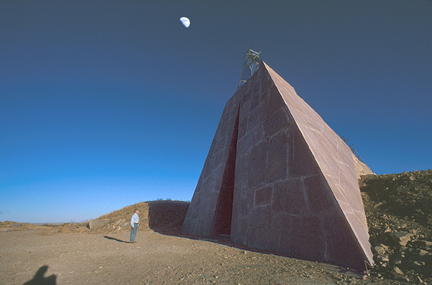
August 17th, 2007
8:15 through 8:30 is tracked across the baseball field in Murray park.
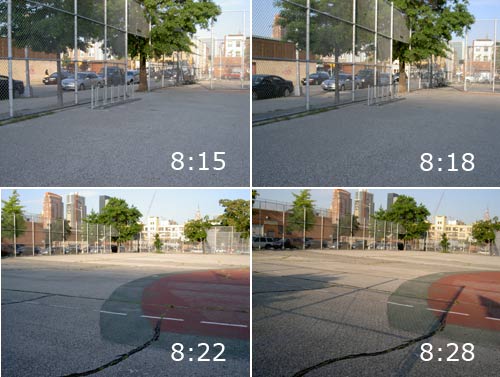
August 14th, 2007
Looking along shadow edge toward tip, which is behind the construction site.
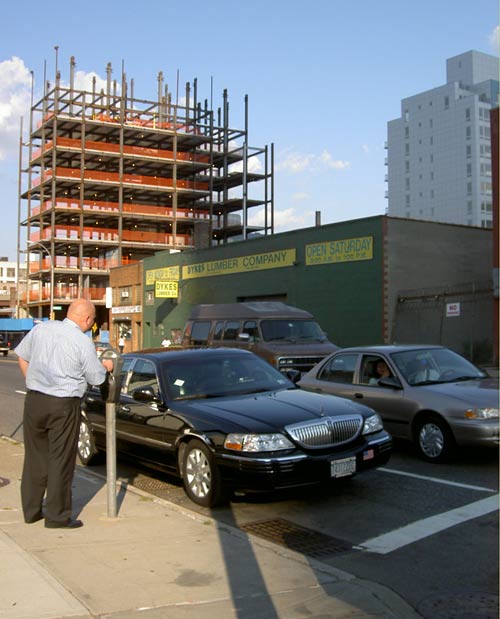
August 7th, 2007
The Sundial Bridge at Turtle Bay crosses the Sacramento River in the heart of Redding, California. Opened July 4, 2004, the bridge links the north and south campuses of Turtle Bay Exploration Park and serves as a new downtown entrance for Redding’s extensive Sacramento River Trail system. It was designed by Spanish architect and engineer Santiago Calatrava.
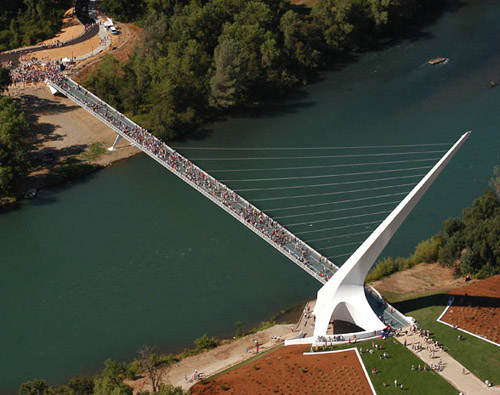
July 29th, 2007

Rockefeller Center, opposite St. Patrick’s Cathedral on 5th Ave. in NYC.
Lee Lawrie and Rene Chambellan, installed in 1937.
From The Art of Rockefeller Center by Christine Roussel:
“Atlas had waged and lost a ten-year war against the gods of Mount Olympus. As punishment, the gods condemned Atlas to support the earth and the heavens on his back for eternity. He had grown weary of the task and was only too glad when Hercules offered to take over his burden. In turn, Hercules said he needed help to complete his eleventh labor, fetching the Golden Apples, which were closely guarded by nymphs called the Hesperides. Prometheus had told Hercules that Atlas could easily complete this labor as he was the nymphs’ father and knew their secrets. When Atlas returned with the apples, Hercules tricked him into resuming the burden of bearing the earth and the heavens on his back for eternity. This statue depicts that never-ending punishment.
The twenty-one-foot-diameter, openwork sphere bears the signs of the zodiac, and its axis points to the North Star. . . . The celestial sphere indicates the earth’s path around the sun, the change of the earth’s axis on its orbit, and the equinoxes.”
July 25th, 2007

Made from over 100 old refrigerators, Fridgehenge (a.k.a ‘Stonefridge’) was put together at a location near near Santa Fe, New Mexico, and completed around 1996 by artist Adam Horowitz. Recent high winds toppled many of the fridges, and the rest was finally removed in June 2007 by city officials who regarded it as a safety hazard. Unlike other Stonehenge replicas, which mimic the astronomical alignment of the original, Fridgehenge had “atomic alignment” and faced Los Alamos National Laboratories, which visitors could see in the distance.
More images of Fridgehenge on Flickr
Overview of Stonehenge replicas & derivatives
Another overview with directions to replicas in the U.S.
July 23rd, 2007
(rainy day post)
As these hors doth pass away so doth the life of men decay
Memento Mori
Disponit tempus dies
Days Make Years
A day may ruin thee improve this hour
AD MDCCXXII
Disce tuos numerare dies
Learn to number thy days
Ecce Horn
Behold, the hour of Destiny!
Thus eternity approacheth
Trifle not your time’s short
Festina Lente
Hasten Slowly
Fugit Dies
The day flies on
Hora Fugit Rapide Lethumq Invadit Inermes
The hours guide swiftly, and the unguarded are easily surprised
Fumus et umbra sumus
Smoke and shadows are we




